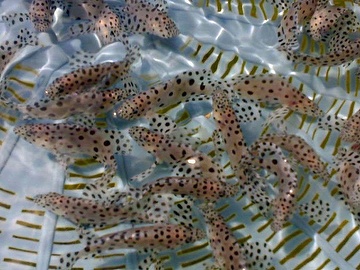I. Background and Current Situation
Taiwan was once the world’s leading supplier of grouper fry, occupying 80% of the global market. However, the outbreak of Nervous Necrosis Virus (NNV) caused fry survival rates to drop below 10%, and mortality rates during grow-out stages have reached as high as 60–80%. In recent years, other aquaculture sectors, such as abalone farming, have also been impacted by unknown diseases. The core issue lies in traditional, intensive farming practices and the lack of safety management:
- High-density farming: Overcrowding and waste accumulation stress the fish and reduce immunity.
- Antibiotic overuse: Frequent disease outbreaks lead to excessive antibiotic usage, which fosters antibiotic-resistant bacteria (superbugs) and leaves harmful residues.
- Environmental degradation: Disease-induced overmedication further disrupts the ecosystem, creating a vicious cycle that undermines aquaculture sustainability.
Modern aquaculture should focus on safe
production, disease prevention, and precision management. Incorporating
technology for monitoring water quality and pathogens, promoting isolated
farming systems, and adopting eco-friendly practices ensures traceable,
high-quality grouper production and long-term industry viability.

II. Overview of Key Viral Pathogens
2.1 Nervous Necrosis Virus (NNV)
- Classification: Family Nodaviridae, genus Betanodavirus.
- Genotypes: SJNNV (striped jack), BFNNV (barfin flounder), TPNNV (tiger puffer), RGNNV (red-spotted grouper), with RGNNV being most prevalent in warm waters.
- Susceptibility: Fry and juvenile fish are highly vulnerable, with mortality rates of 80–100%.
- Transmission: Both vertical (parent to offspring) and horizontal (contaminated water, infected fish, or feed).
- Economic Impact: Severe losses to hatcheries, with symptoms such as erratic swimming, floating, and retinal necrosis.
2.2 Iridovirus
- Notable Strains: Singapore Grouper Iridovirus (SGIV) and Red Sea Bream Iridovirus (RSIV).
- Clinical Symptoms: Lethargy, anorexia, darkened coloration, pale gills, and enlarged spleen.
- Transmission: Mainly through contaminated water and direct contact.
- Mortality: Can reach up to 80%.
III. Common Bacterial Pathogens and Inhibition Potential
The following pathogens are commonly found in grouper aquaculture:
|
Pathogen |
Disease Effects |
ZnO-NPs Inhibition Potential |
Notes |
|
Vibrio alginolyticus |
Ulcers, septicemia |
Medium–High |
Zn2+ also effective |
|
Vibrio harveyi |
Enteritis, skin lesions |
High |
Supported by multiple studies |
|
Aeromonas hydrophila |
Hemorrhagic disease |
High |
Significant in vitro suppression |
|
Vibrio vulnificus |
Acute septicemia |
High |
ZnO disrupts cell wall and RNA |
IV. Introduction to HYZNO N-15 water soluble nano zinc oxide Nanocomposite Particles
"HYZNO N-15 water soluble nano zinc oxide" is formulated using surface-modified nanotechnology, embedding zinc oxide nanoparticles (ZnO-NPs) <6 nm onto organic salt structures. It integrates the antiviral and antibacterial benefits of both ZnO-NPs and Zn2+. Usage: Dilute at a ratio of 1,000–3,750 times with feed and stir thoroughly.
V. Antiviral and Antibacterial Mechanisms
5.1 ZnO-NPs Antiviral Mechanisms
- Blocking attachment: Nanoparticles adsorb onto the virus surface, preventing it from binding to host cell receptors.
- Generating reactive oxygen species (ROS): ROS damage the viral lipid membrane, proteins, and nucleic acids.
- Releasing Zn2+: Dissolved ZnO-NPs release ions that inhibit viral polymerases.
- Antibacterial effects: Effectively suppresses Vibrio and Aeromonas strains.
5.2 Zn2+ Antiviral Mechanisms
- Polymerase inhibition: Directly blocks RNA and DNA polymerase activity.
- Immune modulation: Promotes interferon and other antiviral responses in the host.
- Structural disruption: Binds viral proteins, affecting assembly and stability.
- Antibacterial synergy: Zn2+ also effectively inhibits a range of aquatic pathogens.
VI. Application Recommendations and Conclusion
- Dosage adjustments: Modify dilution rates and frequency based on stocking density, water quality, and pathogen load.
- Integrated management: Combine with isolation strategies and regular diagnostics to reduce antibiotic reliance and environmental stress.
- Safety validation: Conduct small-scale trials to assess fish health and environmental impact prior to full application.
Conclusion:
HYZNO N-15 water soluble zinc oxide nanocomposites offer a dual-action approach via ZnO-NPs and Zn2+, effectively targeting NNV, Iridovirus, and multiple bacterial pathogens. When paired with scientific management and integrated biosecurity practices, this technology can significantly improve fry survival and overall grouper farming efficiency.
